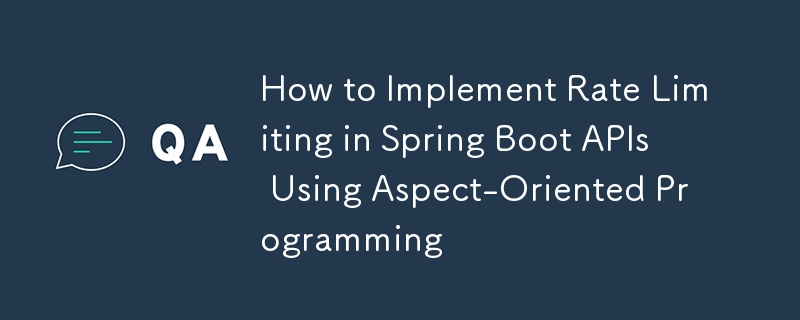
我在业余项目中学到的东西......
简介:面向方面编程(AOP)是 Spring Boot 中的一项强大技术,用于将横切关注点与主应用程序逻辑分离。 AOP 的一个常见用例是在 API 中实施速率限制,即限制客户端在特定时间内可以发出的请求数量。在本文中,我们将探讨如何利用 AOP 在 Spring Boot API 中实现速率限制,确保最佳性能和资源利用率。
面向方面的编程是一种编程范式,旨在模块化软件开发中的横切关注点。横切关注点是影响多个模块的程序的各个方面,并且很难使用传统方法进行模块化。示例包括日志记录、安全性和事务管理。
AOP 引入了方面的概念,它封装了横切关注点。方面是模块化单元,可以跨应用程序的不同部分应用,而无需修改核心逻辑。 AOP 框架(例如 Spring AOP)提供了定义切面并将其应用于应用程序执行流中特定连接点的机制。
速率限制是 Web API 中的一项常见要求,旨在防止滥用并确保资源的公平使用。通过 Spring Boot 中的 AOP,我们可以通过拦截方法调用并限制一定时间范围内允许的请求数量来实现速率限制。
要在 Spring Boot 中使用 AOP 实现速率限制,我们通常遵循以下步骤:
在 Spring Boot API 中实现速率限制可以使用各种技术来实现。一种常见的方法是使用 Spring AOP(面向方面编程)来拦截传入请求并强制执行速率限制。
第 1 步 - 定义速率限制配置: 创建一个配置类,在其中定义速率限制参数,例如允许的请求数量和时间段。
@Configuration
public class RateLimitConfig {
@Value("${rate.limit.requests}")
private int requests;
@Value("${rate.limit.seconds}")
private int seconds;
// Getters and setters
}
第 2 步 — 创建速率限制方面: 使用 Spring AOP 实现一个方面来拦截方法调用并强制执行速率限制。
@Aspect
@Component
public class RateLimitAspect {
@Autowired
private RateLimitConfig rateLimitConfig;
@Autowired
private RateLimiter rateLimiter;
@Around("@annotation(RateLimited)")
public Object enforceRateLimit(ProceedingJoinPoint joinPoint) throws Throwable {
String key = getKey(joinPoint);
if (!rateLimiter.tryAcquire(key, rateLimitConfig.getRequests(), rateLimitConfig.getSeconds())) {
throw new RateLimitExceededException("Rate limit exceeded");
}
return joinPoint.proceed();
}
private String getKey(ProceedingJoinPoint joinPoint) {
// Generate a unique key for the method being called
// Example: method signature, user ID, IP address, etc.
// You can customize this based on your requirements
}
}
第 3 步 — 定义 RateLimited 注释: 创建自定义注释来标记应限制速率的方法。
@Target(ElementType.METHOD)
@Retention(RetentionPolicy.RUNTIME)
public @interface RateLimited {
}
第 4 步 - 实施速率限制器: 创建速率限制器组件,以使用令牌桶算法或任何其他合适的算法来管理速率限制。
@Component
public class RateLimiter {
private final Map<String,RateLimitedSemaphore> semaphores = new ConcurrentHashMap<>();
public boolean tryAcquire(String key, int requests, int seconds) {
// Get the current timestamp
long currentTime = System.currentTimeMillis();
// Calculate the start time of the time window (in milliseconds)
long startTime = currentTime - seconds * 1000;
// Remove expired entries from the semaphore map
cleanupExpiredEntries(startTime);
// Get or create the semaphore for the given key
RateLimitedSemaphore semaphore = semaphores.computeIfAbsent(key, k -> {
RateLimitedSemaphore newSemaphore = new RateLimitedSemaphore(requests);
newSemaphore.setLastAcquireTime(currentTime); // Set last acquire time
return newSemaphore;
});
// Check if the semaphore allows acquiring a permit
boolean acquired = semaphore.tryAcquire();
if (acquired) {
semaphore.setLastAcquireTime(currentTime); // Update last acquire time
}
return acquired;
}
private void cleanupExpiredEntries(long startTime) {
Iterator<Map.Entry<String, RateLimitedSemaphore>> iterator = semaphores.entrySet().iterator();
while (iterator.hasNext()) {
Map.Entry<String, RateLimitedSemaphore> entry = iterator.next();
String key = entry.getKey();
RateLimitedSemaphore semaphore = entry.getValue();
if (semaphore.getLastAcquireTime() < startTime) {
iterator.remove();
}
}
}
private class RateLimitedSemaphore extends Semaphore {
private volatile long lastAcquireTime;
public RateLimitedSemaphore(int permits) {
super(permits);
}
public long getLastAcquireTime() {
return lastAcquireTime;
}
public void setLastAcquireTime(long lastAcquireTime) {
this.lastAcquireTime = lastAcquireTime;
}
}
}
第 5 步 - 注释控制器方法: 用 @RateLimited 注释应限制速率的控制器方法。
@RestController
public class MyController {
@RateLimited
@GetMapping("/api/resource")
public ResponseEntity<String> getResource() {
// Implementation
}
}
第 6 步 - 配置速率限制属性: 在 application.properties 或 application.yml 中配置速率限制属性。
rate.limit.requests=10 rate.limit.seconds=60
还有…
要通过IP地址限制请求,您可以从传入请求中提取IP地址并将其用作限速的关键。以下是您可以修改 getKey 方法以根据 IP 地址生成唯一密钥的方法:
private String getKey(HttpServletRequest request) {
// Get the IP address of the client making the request
String ipAddress = request.getRemoteAddr();
return ipAddress; // Use IP address as the key
}
您还需要修改 RateLimitAspect 类中的 enforceRateLimit 方法,以将 HttpServletRequest 对象传递给 getKey 方法:
@Around("@annotation(RateLimited)")
public Object enforceRateLimit(ProceedingJoinPoint joinPoint) throws Throwable {
// Get the current request from the JoinPoint
ServletRequestAttributes requestAttributes = (ServletRequestAttributes) RequestContextHolder.getRequestAttributes();
HttpServletRequest request = requestAttributes.getRequest();
String key = getKey(request);
if (!rateLimiter.tryAcquire(key, rateLimitConfig.getRequests(), rateLimitConfig.getSeconds())) {
throw new RateLimitExceededException("Rate limit exceeded");
}
return joinPoint.proceed();
}
在此示例中,我们定义了一个自定义注释 @RateLimited 来标记应限制速率的方法。然后,我们创建一个切面 RateLimitAspect,用于拦截用 @RateLimited 注释的方法调用。在该方面,我们使用 RateLimiter 组件强制执行速率限制。
在本文中,我们探讨了如何使用面向方面编程(AOP)在 Spring Boot API 中实现速率限制。通过将速率限制等横切关注点与核心应用程序逻辑分离,我们可以确保应用程序具有更好的模块化性、可维护性和可扩展性。 AOP 提供了解决此类问题的强大机制,使开发人员能够专注于构建健壮且高效的 API。
通过遵循本文概述的步骤并利用 Spring Boot 中的 AOP 功能,开发人员可以轻松在其应用程序中实现速率限制和其他横切关注点,从而实现更具弹性和高性能的 API。
以上是如何使用面向方面的编程在 Spring Boot API 中实现速率限制的详细内容。更多信息请关注PHP中文网其他相关文章!




